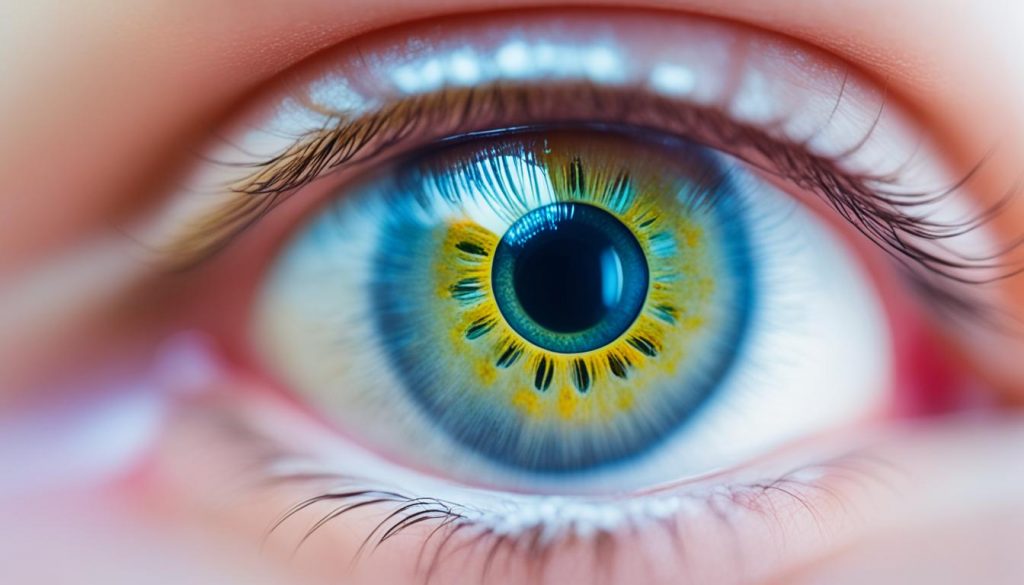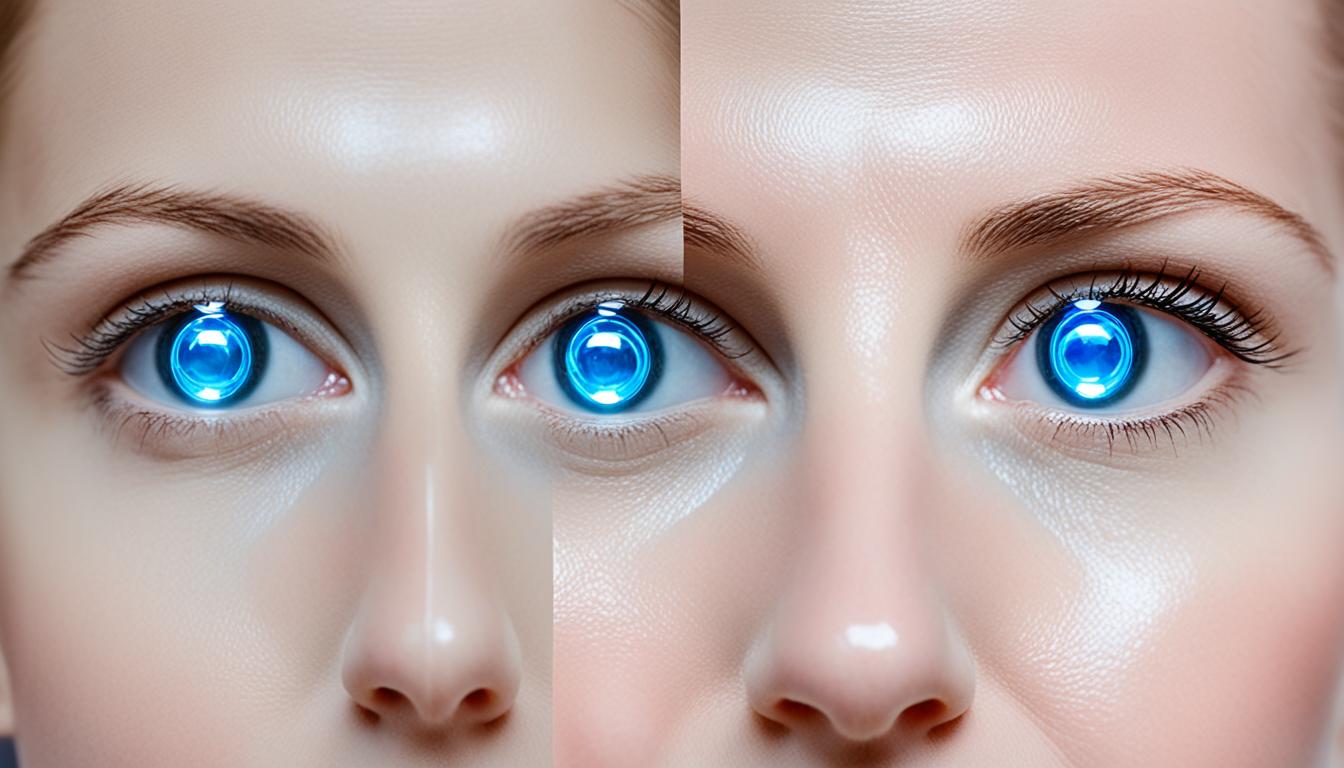Amblyopia, or lazy eye, is a vision problem mostly seen in kids. It leads to poor eyesight or even vision loss in one or both eyes. This happens because the nerves in the eyes don’t grow correctly or on time. If not treated, it can really harm a child’s vision and life.
This article dives deep into amblyopia. We’ll look at what it causes and how to spot it. We’ll also check out the different ways to treat it. Plus, we’ll talk about how stem cell treatment might help. And the key role of keeping an eye on your vision to avoid or fight amblyopia.
Key Takeaways:
- Amblyopia, or lazy eye, often starts in childhood.
- Early treatment is key to managing amblyopia well.
- Ways to treat it include covering the good eye, wearing glasses or contacts, fixing eye alignment, and treating other health issues.
- Stem cell therapy offers hope for better eyesight in those with amblyopia.
- Keeping track of your vision is important to stop amblyopia from getting worse.
Types of Amblyopia
Amblyopia is known as “lazy eye” and has two main types: functional and organic.
Functional Amblyopia: It’s the most usual kind and often found with learning disabilities of binocular vision in childhood. This type is mainly due to refractive disorders. These include astigmatism, myopia, or anisometropia. In this case, the brain uses the stronger eye more, leading to underdevelopment in the weaker eye.
Organic Amblyopia: Organic amblyopia is caused by eye problems like unilateral congenital cataract or ptosis. These issues can harm the eye’s structure or function. The end result is lower vision in that eye. While not as common as functional amblyopia, its treatment is more complex. This is because of the underlying eye issues.
The table below shows the differences between the two types of amblyopia:
| Type of Amblyopia | Description |
|---|---|
| Functional Amblyopia | Amblyopia from childhood binocular vision learning disabilities, due to refractive disorders. |
| Organic Amblyopia | Amblyopia from eye pathologies like unilateral congenital cataract or ptosis. |
Knowing the two main types of amblyopia is crucial for correct diagnosing and treating it. Identifying the cause helps medical experts create treatment plans. These plans work to make the patient see better. They also aim to improve the person’s quality of life.
Symptoms of Amblyopia
Amblyopia, known as lazy eye, shows different signs based on age. Children might blink one eye more, rub their eyes, and have headaches. Noticing these signs early is critical because kids might not talk about eye pain. In grown-ups, untreated childhood amblyopia can cause big decreases in vision.
Identifying Symptoms in Children
Spotting lazy eye in young children can be hard. They might not tell you if something’s wrong. But look out for:
- Blinking of one eye more frequently than the other
- Rubbing or squinting of the eyes
- Closing one eye to see better
- Turning or tilting the head to one side
- Having poor depth perception
Seeing any of these hints means it’s time to see an eye doctor.
Awareness in Adults
If amblyopia wasn’t treated early, it can affect adults too. They might see poorly, have blurry vision, or find depth perception hard. Eye strain and tiredness could also be part of it. It’s vital for adults with these symptoms to get checked by an eye doctor. This can help in figuring out the problem and finding solutions.
Getting regular eye check-ups is crucial for spotting and managing amblyopia. Early action and the right treatment can help a lot in improving how well someone can see.
Diagnosis of Amblyopia
Amblyopia, or “lazy eye,” needs early spotting to stop vision loss. The main diagnosis methods include amblyopia, diagnosis, and pupillary reflex analysis. It checks how well you see things and varies with age.
Evaluation of Visual Acuity
To check eyesight, we look for issues and how clear things are. We use different tests for kids and grown-ups for the best be diagnosis.
Screening for Visual Disturbances
Spotting amblyopia early is key, especially in kids who might not say if they have trouble seeing. A top way to check is through a photo pupillary reflex analysis. This method can help before serious vision harm happens.
Visual Acuity Evaluation in Adults
In grown-ups, diagnosing amblyopia is a detailed check of your sight. They use charts, designs, and look into your health history. Extra tests might also be needed based on your case.
Diagnostic Methods for Amblyopia
| Age Group | Diagnostic Methods |
|---|---|
| Children | Pupillary reflex analysis through photo-screening |
| Adults | Visual acuity evaluation using charts and specialized tests |
Amblyopia Treatment
Early treatment is key for managing amblyopia effectively. The main treatments include:
- Occlusion therapy: This method involves covering the healthy eye. It forces the lazy eye to work harder, improving its vision.
- Glasses or contact lenses: Wearing these corrects vision problems in amblyopia. They ensure both eyes see clearly, aiding visual development.
- Correction of strabismus: Misalignment in the eyes could be behind amblyopia. Treatments like surgery or special glasses might be used to align the eyes, helping binocular vision.
- Treatment of cataracts: If cataracts are the issue, surgery to remove them is necessary. This lets light in, supporting better vision.
- Vision therapy: Sometimes, vision exercises are recommended. These include activities that improve eye movement, focusing, and coordination.
Doctors often combine these treatments for better results. Finding the best plan for an individual requires a doctor’s advice.
Prevention of Amblyopia
It’s key to have a child’s eyes checked often by a pro to prevent amblyopia. Catching and treating problems before age 6 makes it easier to deal with.
Keep an eye out by staying up to date with your child’s vision checks. Regular visits to eye doctors can pick up on issues early. Things like nearsightedness or a misaligned eye that can lead to amblyopia.
Spotting amblyopia soon allows for fast treatment. Actions like covering the healthy eye with a patch, wearing glasses, or exercises can work best in a kid’s first years.
Also, fun eye activities and games can help keep eyes working well together. Playing games that make eyes move and focus are good for keeping vision sharp.
| Prevention Strategies | Benefits |
|---|---|
| Regular monitoring of child’s vision | – Early detection of refractive errors and eye conditions – Prompt intervention and treatment |
| Providing a stimulating visual environment | – Promotes healthy visual development – Encourages use of both eyes |
| Promoting activities that require binocular vision | – Enhances visual coordination and development |
Stem Cell Therapy for Amblyopia
Modern research is looking at how stem cell therapy might treat amblyopia. It’s looking into corneal stem cells and limbal stem cells. These could be used as a new kind of treatment to improve sight in people with amblyopia.
Experts think using stem cells could really help people with amblyopia see better. This method focuses on repairing the eye through cell regeneration. It might be a way to make the eyes work better, using the body’s own healing power.
Even though using stem cells for amblyopia is just starting out, results look good. Scientists are finding the best way to use stem cells for the eyes. The goal is to use this knowledge to help people with amblyopia in the future.
Current Developments and Future Prospects
Scientists are really interested in limbal stem cells for treating amblyopia. These cells can become different eye tissues, like the cornea. The hope is to use these cells to fix the cornea and improve vision in people with amblyopia.
They’re also looking at corneal stem cells. These cells are good at treating eye surface issues. They might work well for the cornea problems that come with amblyopia.
There’s a lot we still need to figure out about using stem cells for amblyopia. But, research is moving fast. There’s a chance this new treatment could really change how we fight amblyopia one day.
| Advantages of Stem Cell Therapy for Amblyopia | Challenges and Considerations |
|---|---|
|
|
Surgical Management of Amblyopia
When amblyopia is complicated by active conjunctival inflammation, surgery gets more complex. It often includes lr-CLAL and KLAL. These aim to fix vision problems, improving how well you see.
Sometimes, surgeons mix these surgeries with things like amniotic membrane transplantation. This helps the eyes heal and gets better visually.
These surgeries need a lot of care after, both with eye drops and a special kind of medicine. Regular check-ups are crucial to make sure everything is working well.
Which surgery is right for you depends on your eye doctor’s advice. They’ll think about what will help you see better, weighing both the good and not so good sides of each choice.
Research on Surgical Treatment Options for Amblyopia
Researchers are looking into new ways to treat amblyopia with surgery. The Cincinnati Procedure mixes a special eye drop with surgery. It’s shown it can help people see better in some cases.
It’s key to keep up with the newest in eye surgery for amblyopia. New discoveries could mean even better results for those with amblyopia.
Caption: Surgical treatment options for amblyopia aim to correct visual irregularities and improve visual acuity.
Ocular Allergies and Amblyopia
Ocular allergies like seasonal or year-round types can happen with amblyopia. They can make amblyopia worse and affect vision if not managed well.
Seasonal allergic conjunctivitis comes at certain times, often from pollen. It makes eyes red, itchy, and watery. This can make amblyopia symptoms worse.
Perennial allergic conjunctivitis happens all year due to indoor irritants. These include dust, pet dander, and mold. It results in constant eye itching, redness, and discharge. This makes managing amblyopia more complex.
Vernal keratoconjunctivitis is a persistent issue, often in kids and young adults. It makes eyes itch intensely, get red, and be sensitive to light. There’s also a thick discharge. Amblyopia care might be harder due to the eye discomfort and swelling.
Atopic keratoconjunctivitis is a severe eye allergy linked to skin conditions. Severe cases can cause eye surface damage and vision loss. Caring for this along with amblyopia needs special attention from an eye doctor.

Handling ocular allergies well is key for good vision in those with amblyopia. This includes staying away from allergens, using doctor-prescribed drops, or taking allergy meds. It also means keeping the eyes clean. Getting advice from an eye care expert is crucial. They can help make a treatment plan that works for both allergies and amblyopia.
Conclusion
Amblyopia, or lazy eye, often affects kids and needs quick action. Early treatment with glasses, occlusion therapy, or fixing a crossed eye is key. Targeting it soon can keep kids from losing vision.
New hope for amblyopia comes from stem cell research. Using stem cells from corneas and limbus might help. This could mean better sight and life for those with amblyopia.
It’s important to not ignore allergies that might lead to amblyopia. Checking often and treating early will help kids see better. Keep up-to-date on amblyopia care to do your best.

